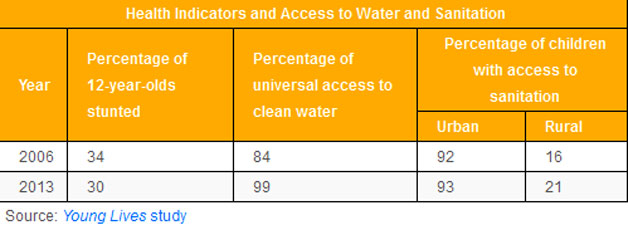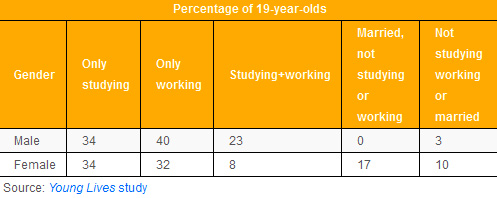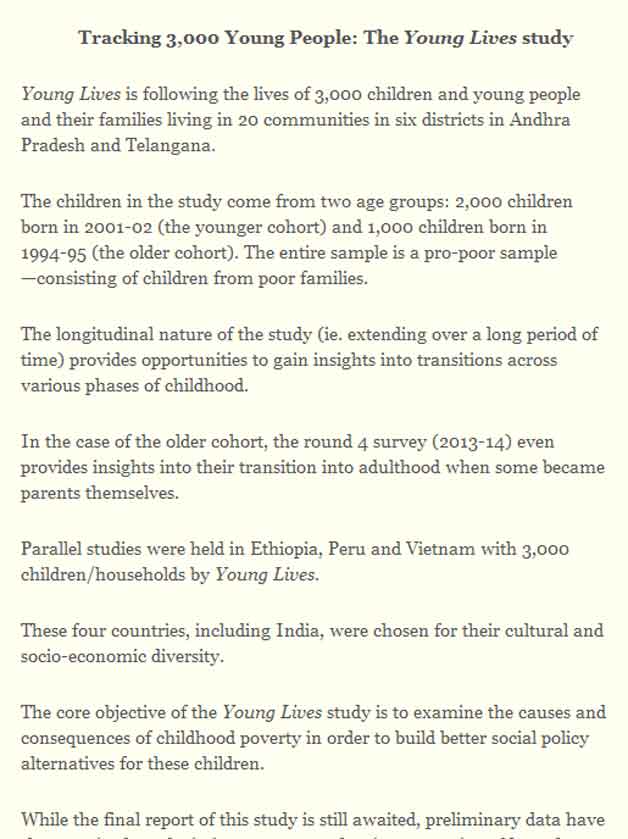
- 97% of 12-year-olds were enrolled in elementary schools in 2013; up from 89% in 2006.
- Almost a third of children continue to show signs of malnutrition at age 12 with high rates for economically- and socially-marginalised children and those in rural areas.
- 49% of older children were still in school at the age of 19; 9% had yet to complete secondary education, 8% had moved on to vocational or post-secondary education and a third had started university.
The report shows positive trends in school enrolment and some indicators like access to clean drinking water. However, nutrition and sanitation, especially in villages, continues to be poor. Also, the situation of youth, especially young women, has not improved much.
The study has released preliminary data in three aspects: education, health and development.
Education and Learning
While significant improvement has been found in enrolment in schools for 12-year-olds by the Young Lives study, IndiaSpend has reported a significant drop in enrolment at the higher-secondary level in India.

The Young Lives study also found that there has been considerable progress in addressing inequalities in school enrolment in the past few years, especially the gender gap—where enrolment of boys and girls was almost equal compared to a difference of 4 percentage points in 2006. However, inequalities related to segregation of the poorest children into government schools and the dip in learning levels across both private and government schools continue.
There are worrying signs with the study revealing a fall in learning standards since 2006, with only half the children able to answer maths questions correctly, compared with two-thirds of children in 2006.
Nutrition and Health
Stunting in children due to malnourishment has not changed much—there was an improvement of only 4 percentage points in 8 years, according to data in the Young Lives study.

Socially-marginalised groups and the poorest households need to be targeted in efforts to reduce malnutrition, according to this study with more than a third of scheduled caste, scheduled tribe and other backward caste children being thin compared to a quarter of children from other castes.
IndiaSpend has also reported how malnourishment is turning out to be fatal for children across the country; about 56 out of 1,000 kids under the age of five died in India in 2012 due to malnutrition, according to the Global Nutrition Report.
Youth and Development
The study has reported how children from economically- and socially-disadvantaged backgrounds were the most likely to have left school, many without gaining a secondary-level certificate.

51.5% of the total cohort of 19-year-olds had left school, with only 15.8% achieving secondary education.
Many young people from marginalised groups had already started full-time work, mostly self-employed or wage-employed in agriculture, with no further education or vocational skills.
IndiaSpend's earlier reports have shown how youth are affected by lower levels of education and skills.

While 36% of girls were married by the age of 19, according to the study, only 2% of boys were married at that age.
Despite the legal age for marriage being 18, 37% of girls were married by 19 (an average age of 16.6 years, below the legal age). And 108 of them, from the selected cohort, already have a child of their own (almost two-thirds of the married girls).
Education and maternal health is adversely affected if girls marry early.

(Indiaspend.org is a data-driven, public-interest journalism non-profit)

















